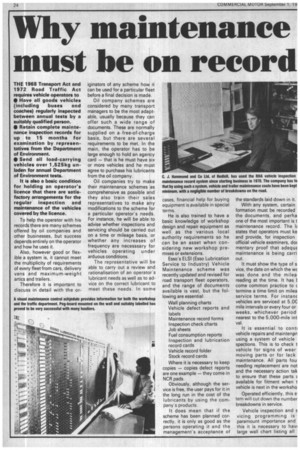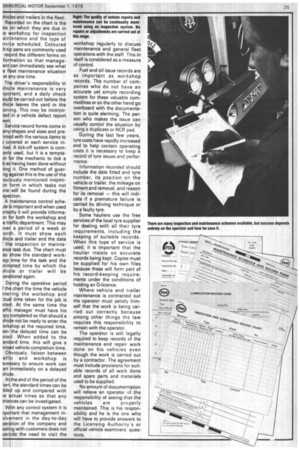Why maintenance must be on record
Page 26

Page 27

If you've noticed an error in this article please click here to report it so we can fix it.
THE 1968 Transport Act and 1972 Road Traffic Act requires vehicle operators to • Have all goods vehicles (including buses and coaches) regularly inspected between annual tests by a suitably qualified person.
• Retain complete maintenance inspection records for up to 15 months for examination by representatives from the Department of Environment.
• Send all load-carrying vehicles over 1,525kg unladen for annual Department of Environment tests.
It is also a basic condition for holding an operator's licence that there are satisfactory arrangements for the regular inspection and maintenance of the vehicles covered by the licence.
To help the operator with his records there are many schemes offered by oil companies and other businesses, but success depends entirely on the operator and how he uses it.
Also, however good or flexible a system is, it cannot meet the multiplicity of requirements of every fleet•from cars, delivery vans and maximum-weight artics and trailers.
Therefore it is important to discuss in detail with the or iginators of any scheme how it can be used for a particular fleet before a final decision is made. Oil company schemes are considered by many transpOrt managers to be the most adaptable, usually because they can offer such a wide range of documents. These are normally supplied on a -free-of-charge basis, but there are several requirements to be met. In the main, the operator has to be large enough to hold an agency card — that is he must have six or more vehicles and he must agree to purchase his lubricants from the oil company.
Oil companies try to make their maintenance schemes as comprehensive as possible and they also train their sales representatives to make any modifications to the scheme for a particular operator's needs. For instance, he will be able to advise whether inspections and servicing should be carried out on a time or mileage basis, or whether any increases lof frequency are necesssary for vehicles operating under arduous conditions.
The representative will be able to carry out a review and rationalisation of an operator's lubricant needs as well as to advice on the correct lubricant to meet these needs. In some cases, financial help for buying equipment is available in special terms.
He is also trained to have a basic knowledge of workshop design and repair equipment as well as the various local authority requirements so he can be an asset when considering new workshop premises or extensions.
Esso's ELS! (Esso Lubrication Service to Industry) Vehicle Maintenance scheme was recently updated and revised for road transport fleet operators, and the range of documents available is vast, but the following are essential Wall planning charts Vehicle defect reports and I abels Maintenance record forms Inspection check charts Job sheets Fuel consumption reports Inspection and lubrication record cards Vehicle record folder Stock record cards Where it is necessary to keep copies — copies defect reports are one example — they come in NCR pads.
Obviously, although the service is free, the user pays for it in the long run in the cost of the lubricants by using the company's products.
It does mean that if the scheme has been planned correctly, it is only as good as the persons operating it and the management's acceptance of
the standards laid down in it.
With any system, certain formation must be recorded the documents, and perha one of the most important is t maintenance record. The k states that operators must ke and provide, for inspection official vehicle examiners, dot mentary proof that adequE maintenance is being carri out.
It must show the type of s. vice, the date on which the wc was done and the mile& reading at the time. It has t come common practice to c termine a time limit on m ilea service terms. For instanc vehicles are serviced at 5,0C mile intervals or every four or : weeks, whichever period nearest to the 5,000-mile int val.
It is essential to conti vehicle repairs and maintenan using a system of vehicle spections. This is to check t vehicle for signs of wear moving parts or for lack maintenance. All parts fou needing replacement are not and the necessary action tak to ensure that these parts C available for fitment when t vehicle is next in the worksho Operated efficiently, this s, tern will cut down the number breakdowns in service.
Vehicle inspection and s vicing programming is paramount importance and this it is necessary to hay( large wall chart listing all • )hic es and trailers in the fleet.
orded on the chart is the 3te in which they are due in ie orkshop for inspection amn enance and the type of trvi e scheduled. Coloured It-ti pens are commonly used re ord the different forms on for ation so that manageent can immediately see what e ft et maintenance situation at ny one time.
Th driver's responsibility in 3hi le maintenance is very tant, and a daily check mu! • be carried out before the thic e leaves the yard in the orn ng. This may be incorpoted in a vehicle defect report ieet.
Service record forms come in an shapes and sizes and pred with the various items to c vered at each service inrval A tick-off system is comonl used, but it is a tempta)n sr the mechanic to tick a b a having been done without )in it. One method of guarng gainst this is the use of the .evi usly mentioned inspec)n orm in which tasks not )ne will be found during the spe tion.
A aintenance control sche jlei and when used gre tly it will provide informa)n f r both the workshop and e tr ffic department. This may we a period of a week or on h. It must show each thic e and trailer and the date th inspection or nnaintemc task due. The chart must so how the standard worktop time for the task and the ;ti ated time by which the hi 'le or trailer will be )er tional again.
D ring the operative period th chart the time the vehicle nte ing the workshop and 7,tu I time taken for the job is ote . At the same time the affi manager must have his )py ompleted so that should a hi le not be ready to enter the .ork hop at the required time, ten the delayed time can be ote . When added to the an ard time, this will give a visd vehicle completion time. 0 viously, liaison between aff c and workshop is ece sary to ensure work can art immediately on a delayed 3hi e.
At the end of the period of the -Ian the standard times can be kle up and compared with te ctual times so that any 3ria ces can be investigated.
W th any control system it is npo ant that management in )Iv ment in the day-to-day per tion of the company and eel' g with customers does not ver ide the need to visit the
Right: The quality of vehicle repairs and maintenance can be continually monitored using an inspection system. No repairs or adjustments are carried out at this stage.
workshop regularly to discuss maintenance and general fleet operations with the staff. This in itself is considered as a measure of control.
Fuel and oil issue records are as important as workshop records. The number of companies who do not have an accurate yet simple recording system for these valuable commodities or on the other hand go overboard with the documentation is quite alarming. The person who makes the issue can usually control the situation by using a duplicate or NCR pad.
During the last few years, tyre costs have rapidly increased and to help contain operating costs it is necessary to keep a record of tyre issues and performance.
Information recorded should include the date fitted and tyre number, its position on the vehicle or trailer, the mileage on fitment and removal, and reason for its removal — this will indicate if a premature failure is carried by driving technique or by a faulty tyre.
Some hauliers use the free services of the local tyre supplier for dealing with all their tyre requirements, including the keeping of suitable records. When this type of service is used, it is important that the haulier insists on accurate records being kept. Copies must be supplied for his own files because these will form part of his record-keeping requirements under the conditions of holding an 0-licence.
Where vehicle and trailer maintenance is contracted out the operator must satisfy him self that the work is being carried out correctly because among other things the law requires this responsibility to remain with the operator.
The operator is still legally required to keep records of the maintenance and repair work done on his vehicles even though the work is carried out by a contractor. The agreement must include provisions for suitable records of all work done and spare parts and materials used to be supplied.
No amount of documentation will relieve an operator of the responsibility of seeing that the vehicles are properly maintained. This is his respon sibility and he is the one who will have to provide answers to the Licensing Authority's or official vehicle examiners' questions.




































































































